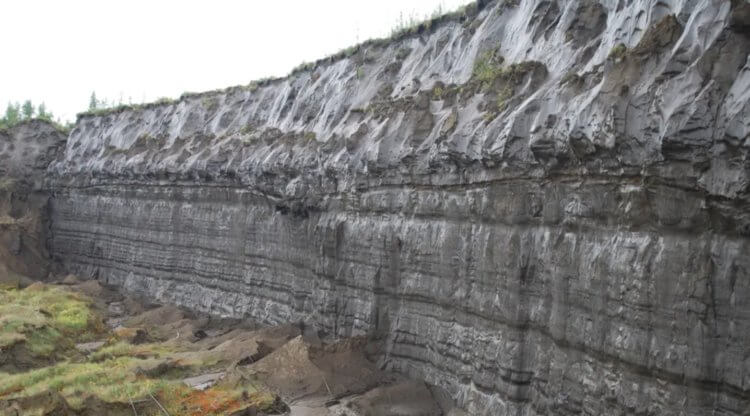In the 1960s, not far from the Yakut village of Batagai, a large forest was cut down. This led to the fact that the permafrost in this area began to melt, and a depression 1 kilometer long and about 100 meters deep formed on the ground. For a long time, no one knew about the existence of this formation, because it is located far from human settlements, and after deforestation, no one went to these places. The crater was discovered only in the 1990s, during the study of satellite images. It was given the name Batagaika, and is also sometimes called the“gate to the underworld.”Scientists are closely monitoring the changes occurring in it. Recently it was found that since its formation it began to increase rapidly, and this is considered a bad sign.

The Batagaika crater from above resembles a fish. Image source: yakutia.info
Batagai crater in Yakutia
Batagaika is the largest permafrost crater in the world. It is located in the depths of Russia, in the taiga near the village of Batagai. This place is separated by 660 kilometers from Yakutsk, the capital of the Sakha Republic. Considering the harsh weather of these regions, getting to the Batagai crater is not so easy.
The crater was formed due to a combination of different factors. Firstly, after cutting down a huge number of trees in the second half of the 20th century, the land began to sag significantly. Secondly, the absence of forests led to the fact that the permafrost began to quickly melt under the influence of sunlight. Thirdly, the crater has expanded due to periodic floods.

Batagaisky crater on the map. Image source: iflscience.com
Calculations by scientists have shown that the age of permafrost in the Batagai crater is about 650 thousand years. Researchers conducted excavations and were able to find the remains of plants and animals from the Ice Age in the depression. The bones of mammoths and ancient horses, 4,400 years old, no longer surprise us, because we often write articles on this topic. But the fact that the remains of a musk ox were discovered in the general depression is of interest. We may soon have an article about these amazing creatures, so be sure to subscribe to our social networks.
Everyone should know this:How does global warming differ from climate change?
The melting of permafrost in Siberia
Judging by satellite images, the Batagaika crater is constantly increasing in size. According to scientists, every year it grows by about 15 meters, and this is a very impressive figure.
Recently, an article was published in the scientific journal Geomorphology with the results of a study conducted by Russian and German scientists. Together they created a 3D model of the Batagai crater to understand its past, present and future. Model analysis showed that since the 1990s, permafrost collapse has displaced 35 million cubic meters of soil.

The edges of the Batagai crater. Photo credit: Alfred-Wegener-Institute/Thomas Opel
The crater in Yakutia is growing very quickly in size, not only in length, but also in width. For example, in 2014, the width of Batagaika was 790 meters. The permafrost did not stop the melting, so already in 2019 the width of the crater increased to 890 meters. Scientists believe that this is due to global warming, the effects of which are noticeable in almost every corner of the Earth. Scientists already know that global warming will not only affect people's lives, but will also cause the extinction of many animals, such as bees. The enlargement of the permafrost crater is another reminder that global warming is real and something needs to be done about it.
Read also:Four ways to stop global warming
Permafrost craters
The Batagai crater is the largest of its kind, but not the only one. Due to the gradual increase in average temperature on Earth, such collapses are increasingly appearing in the northern regions. For example, in 2019, scientists discovered thousands of similar craters in the high Arctic that had formed over the past few decades. The consequences of permafrost thawing are especially noticeable in Russia, because we have especially many cold regions.

Another crater on the Yamal Peninsula. Photo source: popsci.com
Do you want to discuss the news about the enlargement of the Batagai crater, but have no one to talk to? Take a look at our Telegram chat, where you will definitely find an interesting interlocutor!
The thawing of permafrost poses many dangers. The biggest concern is that ancient ice may contain bacteria and viruses, against which modern people have no immunity. If they suddenly get out, a new pandemic of an unknown disease may begin in the world. You can read more about this in the article by my colleague Lyubov Sokovikova “Factor X – what is hidden in the permafrost?”